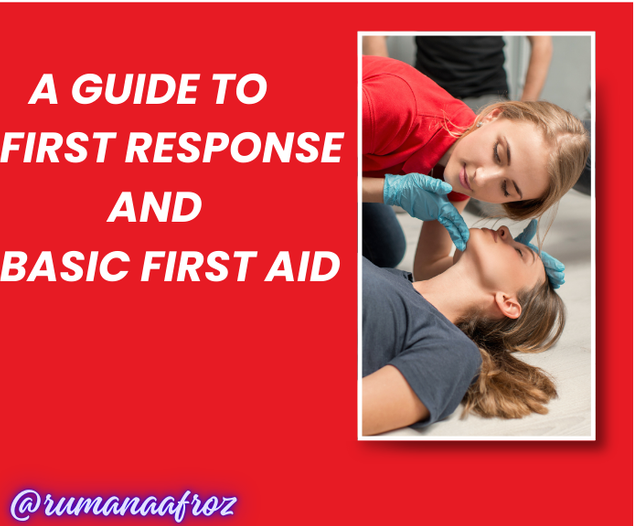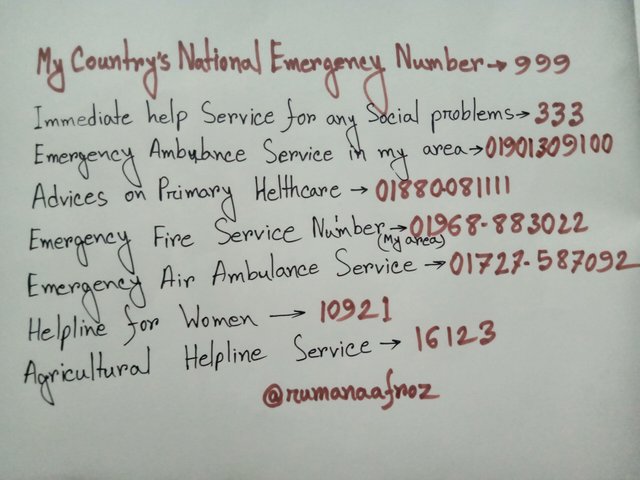Bismillahir Rahmanir Rahim
Bismillahir Rahmanir RahimI am taking part in this challenge to get better trained in first aid in the first week of the 21st season of the A Guide to First Response and Basic First Aid class.

Created by CanvaShare any experiences in your life where you faced an emergency that could have been handled by yourself if you knew basic first response skills.
Yes, I faced such an emergency once. My niece has a 10 month old baby girl. Last month, she got food stuck in her throat and her mother was blowing on her head without realizing it, which made it harder for her to breathe, her eyes were red and big, and there was only a slight cough. I immediately took the baby from him and placed it between his legs and under his stomach and took his chin in my left palm and quickly lifted his left leg on the bed and placed the baby on my leg and slightly lowered his head and gave him a medium-force push with my right palm 5 times and Alhamdulillah the baby cried loudly and the piece of noodles came out of his throat. Fortunately I knew first aid from watching YouTube videos due to which I was able to dedicate myself to first aid without being scared at that moment and was successful. I saw my sisters' tears filled with laughter which was a great joy for me.
Imagine that you are returning home, when you witness a road accident between a car and a motorcycle, and the motorcycle driver is lying on the road, not moving. There is some blood oozing from his leg, and he seems unconscious. You are the first responder, how would you handle this scenario?
If I were a first responder in a road accident, I would say I am completely ignorant about this. Because I have no idea about this, in such a situation, I would first apply the methods you have taught me step by step from your class. The 5 steps you have taught will definitely help me. For example,
A. Danger
First of all, I will check how safe the accident site is for me because if it is not safe, if I go there and get into danger myself, the situation will become uncomfortable. I will occasionally check whether the fire from the car through liquid, speeding cars on the road, broken glass or mirrors from the car will hinder me. If I feel in danger, I will quickly take him to a safe place through the people present. Because you have taught me through this class that one should prioritize one's own safety first and not put oneself in danger.
B. Response
After taking the person to a safe place, I will first gently tap his or her shoulder or face to check if he or she is responsive and ask him or her in a small, easy voice, can you hear me? Or are you okay? If he or she responds, that is good news. If they are aware of this, I will reassure them in a very calm voice. It will help them feel more comfortable and reduce their panic, which may lead to better outcomes. If they are not responsive, then I will move on to the next step you have taught me.
In the meantime, if I have the opportunity or I will ask someone in the crowd to call an ambulance. If they do not know the helpline number, I will tell them and help them. For example, the helpline number in my country is 999.
C. Airway
Next, I will first check whether the casualty's airway is open and clear. If not, I will carefully tilt their head back and lift the chin to open the airway, check for any visible obstructions in the mouth or throat that could be blocking the airway, such as food, blood. I will focus on maintaining an intact clear airway until professional help arrives.
D. Breathing
Next, I will try to determine if the person is breathing normally by listening to the rise and fall of their chest, listening for breath sounds, and feeling the warmth or breath on their cheeks. If they are breathing normally, that is great. If they are not breathing at all or breathing abnormally, I will perform CPR (cardiopulmonary resuscitation), which we will learn from you in the next class.
E. Circulation
Finally, according to the protocol, I will check the person for circulation and see if there is any serious bleeding. I will check the casualty's pulse in the arm or neck area according to the method you have taught. Then, if they are bleeding heavily, I will apply firm pressure to the bleeding wounds with a clean cloth from myself or from a bystander. And I will keep the injured area elevated to reduce blood loss.
Then, when the emergency services arrive, I will tell them what kind of first aid I gave them and what happened.
Draw or create an attractive diagram/flowchart of the DRABC protocol (try to be creative and don't forget to add your username to the diagram)( 2.5 marks)
I will now give a short account of what I have learnt from this class about a DRABC protocol,
D=Danger
R=Response
A=Airway
B=Breathing
C=Circulation
.png)
Write down on a piece of paper the numbers of emergency services in your country/region (minimum 5, maximum 10) (1.5 marks)

I will respectfully call on the attention of my friends and colleagues @simonnwigwe @josepha @marito74 to take part in this contest thanks.
Thanks alot for reading .
Good luck to you.
Good luck to you.
Rumana Afroz

Hello, I congratulate you for that quick response that undoubtedly saved the child's life, he could have drowned, fortunately he was there. Usually when we are new mothers we get nervous and it is important to stay calm and act appropriately. I wish you success on your journey.
Downvoting a post can decrease pending rewards and make it less visible. Common reasons:
Submit
Thank you very much for congratulating me. If you can help someone in danger, it is a very kind thing to do. I hope that I will be better trained in this matter in the future classes.
Downvoting a post can decrease pending rewards and make it less visible. Common reasons:
Submit
It is high time that we actually need to learn first response because of emergency reasons because I have actually come to discover that it can go a long way to help and even save a life. I also experienced similar situation that I should have helped someone assuming I learnt the principle of first response but I wasn't able to offer a help which was actually very devastating. Sometimes some people have lost their life because there are not people who are capable of saving the life at the very initial moment. It is very critical that we learn this CPR skill also.
I also love how you analyse what you said you will do. Yes you are right. The first thing to actually do is to make sure that the scene and the victim is safe from any danger again even before moving to check responses. It is very needed to protect the victim life. It must also have been devastating at that particular time seeing your 10 month old niece looking for help. It must have really been a very terrifying moment then I believe. Thank you so much for that which you have shared here. I was really able to actually learn quite a lot beyond what I can imagine of.
Downvoting a post can decrease pending rewards and make it less visible. Common reasons:
Submit
Yes friend the creator sent me there as a helper at a time when the child's mother fainted which could have caused great harm to the child. But through this class we got details on helping which will be useful in our journey. Wish you all the best.
Downvoting a post can decrease pending rewards and make it less visible. Common reasons:
Submit
Congratulations, your post has been upvoted by @scilwa, which is a curating account for @R2cornell's Discord Community. We can also be found on our hive community & peakd as well as on my Discord Server
Felicitaciones, su publication ha sido votado por @scilwa. También puedo ser encontrado en nuestra comunidad de colmena y Peakd así como en mi servidor de discordia
Downvoting a post can decrease pending rewards and make it less visible. Common reasons:
Submit